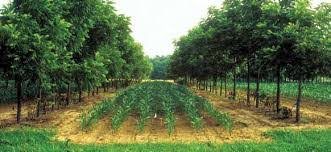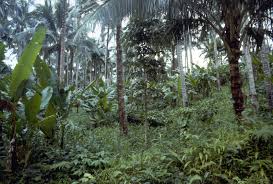AGROFORESTRY- FEATURE,TYPES & BENEFITS
DEFINITION
Basically Agroforestry is defined as land-use management systems wherein, woody perennials such as trees, shrubs, palms, bamboos, etc. are grown around or among crops or pastureland. This system is used on the same land-management units as agricultural crops and/or animals, in some form of space and/or time arrangement sequence.
MAIN FEATURE–
- The three mains components of agroforestry are animals, crops and trees, which can be combined in numerous spatial (space) and temporal (time) arrangements for different functions which names different kinds of systems.
- In agroforestry systems, there are both ecological and economical interactions between the different components, thus it enhance the functionality and sustainability of the farming system.
- It is a dynamic, ecologically based natural resource management system that, through the growing of trees around or among crops or pastureland, diversifies and sustains production for increased social, economic and environmental benefits for farm/land holders at all levels.
- Agroforestry is 6-F programme because, it provides- FOOD for people, FEED for livestock, FIBRE, FUEL for homes, FURNITURE for timbers and also FUND raising.

Agroforestry-Provides Alternate Farming - Such farming practices are highly beneficial in the tropics, especially in subsistence smallholdings and developing country. That’s why it has been proposed by Roger Leakey as a means to ‘reboot’ tropical agriculture.
- So the necessity of agroforestry is very due to continuous supply of fuel, food, fodder and to maintain ecological balance. It provides diversified and more sustainable production which is very important.
TYPES-
There is three prevalent types of agroforestry systems:
- Agrisilvicultural systems (Agricultural crops+Forest crops)– This system combines crops and trees, such as alley cropping or home gardens.
- Silvopastoral systems (Silviculture+Pasture management)– It combines forestry and grazing of domesticated animals on pastures, rangelands or on-farm too.
- Agrosylvopastoral systems (Agricultural crops+Forest crops+Pasture management)– The integration of all the three elements, namely trees, animals and crops is called Agrosylvopastoral systems. Home gardens involving animals as well as scattered trees on croplands used for grazing after harvest is an example.
BENEFITS –
- Environmental–
- Integrating trees in agricultural systems can help to reduce impact of climate change or global warming through carbon sequestration. Sourcing wood products on farm decreases the need to cut forest trees, thus reduces the rate of deforestation, which is one of the main factors contributing to climate change.
- It improves and conserves biodiversity because, it provides more diverse habitat than conventional system. The tree component creates ecological habitat/place for a wide range of organisms both above and below ground.
- It improves soil structure and health, reduce erosion, as it provides soil cover and maintaining water availability. It provides better management of soil nutrients and thus reduces the need of chemical fertilizers, another significant source of GHG emissions.
- By using wood, fuel from agroforestry systems, people can meet their energy needs in a carbon neutral way.
- By providing cover to sensitive crops or animals, agroforestry can help in maintaining or increasing yields in the face of climate change, strengthening agriculture’s resilience.
- This integrated forestry system protects natural resources and therefore provides many services for the local, national and global community in many ways such as filtering and capturing of water resources, increase and protect local biodiversity through creating suitable environment for organisms, restore soil fertility by using N-fixing legumes.
- Economic–
- Planting trees together with crops or on pasture lands provides different food and fodder items for man, animals and other organisms too. It provides basic needs of farmers such as, food, fruit, fodder, fuel etc. from their same piece of land. Thus agroforestry improves food and nutrition security.

Multistory coconut based Agroforestry - It also provides fuel for local people and play important role in water supply through filtering and storing water.
- Trees and plants grown on farms are important sources of medicines and natural remedies, which is important for human health.
- Agroforestry helps to reduce poverty by supporting extra surplus. With the production of agricultural and forest goods with higher value, farmers and foresters can receive a better return for their labor.
- Agroforestry becomes very helpful after occurrence of natural hazards, disasters and socioeconomic downturns by reducing losses through providing diverse production management system. Trees act as shelterbelt, store water, reduces erosion and provides cover to other sensitive crops.
- Agroforestry is crucial to smallholder farmers and other rural people because it can enhance their food supply, income and health.
- Agroforestry systems are multi-functional systems that can provide a wide range of economic, sociocultural, and environmental benefits.
3. Social– - Agroforestry can help local communities and cultures thrive. It can improve gender equality by providing social security. Hence, it plays important role for community development.
WHAT IS WEEDS-CHARACTERISTIC, CLASSIFICATION & CONTROL
CASH CROPS-DEFINITION & EXAMPLE
WATER HARVESTING-DEFINITION,TYPES & ADVANTAGES
SUSTAINABLE AGRICULTURE-DEFINITION & IMPORTANCE
CROPPING PATTERN-CROPPING SYSTEM
INTEGRATED FARMING SYSTEM